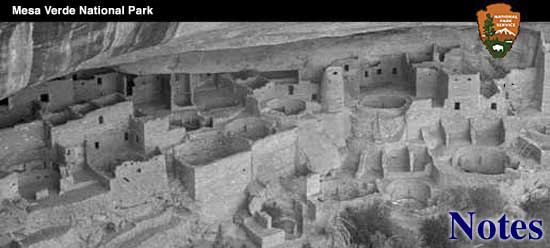

|
In thinking of evergreens we are inclined to at once picture the spruce, pine and juniper trees that remain green throughout the year. There are many other evergreens, small shrubs that delight the hostess for holiday decorations. It is in mid-winter, when the ground is covered with snow, deciduous trees and bushes are leafless, that the appearance of a green plant in some sheltered ledge appeals to all. When these small evergreens are mixed with the needles and cones of conifer trees, in wreath or spray, a real charm is imparted to the whole. The Mesa Verde Flora includes some of these smaller evergreens and a few are so unusual that many a question is asked about them. Several played an important part in the life of the Cliff Dweller during his occupation of the mesa. MOUNTAIN LOVER. The Mountain Lover is one of the handsomest small evergreens found in the park. It is a low shrub with smooth, oblong, opposite leaves. The plant is erect or often prostrate; growing in dense masses it appears to be trailing. The flowers are very small and inconspicuous. Leather-like capsules, containing one to two seeds, are enclosed in a white hood and appear to be berries. This small shrub is often mistaken for Kinnikinnick due to its similar habit of growth. Here in the park it selects moist canon sides, often covering the ground. An analysis of the contents of some Cliff Dweller pipes shows that dried leaves of the Mountain Lover were used for smoking. Far from a pleasant tasting smoke, it was evidently used only in ceremonials.
OREGON GRAPE A low trailing glabrous shrub with very sharply pointed leaves. This plant resembles the Eastern Holly in general appearance. The small, delicate yellow flowers, in racemes, are followed by a globular berry. The resemblance of these berries to the wild grape accounts for the common name of this plant. The fruit is sour but of pleasant taste and makes delicious jelly. In the late autumn the leaves have a tendency to turn red in color, and this contrasts well with the handsome blue-purple berries. It commonly grows in moist shady canons.
-oOo- YUCCA Few people realize that this plant retains its blue-green color throughout the year. The long lance-like leaves add a most picturesque appearance to the Pinon and Juniper forest. The plant is known by many names in different localities. Soapweed, Indian banana, and Spanish Bayonet are soubriquets often applied. Consisting of the long sharp-pointed leaves which are very thick and rigid, and having no trunk the plant is intensely interesting and attracts much attention on this mesa. Every few years it sends out a thick flowering stalk which rises to about a foot above the tallest leaves. It blooms during the month of June. The white flowers, large and pendulous, are followed by oval fruit which hang downward and turn purplish when ripe. The Yucca can really be considered the most important plant to the Cliff Dweller. It furnished them the fibres for weaving ropes, baskets and clothing. The root when pounded and then rubbed in water develops a lather and this will cleanse like soap. Hence the name Soapweed. The fruit is edible and was gathered by the Indians. Many of the dried pods have been found in the cliff ruins. Even to this day the plant is much used by the Indians of the Southwest.
The intimate relationship that exists between the flowers of the Yucca and a genus of moths called pronubos is so interesting that it is worth your time to look up the full story. Dependent upon each other, the flower is pollinated by the moth and in return for this gift furnishes food to the young, or caterpillars of the moth. -oOo- MISTLETOE Up in the branches of the Juniper trees are often seen dense clusters of green branches. This is mistletoe, a parasitic plant growing out of the branches of different species of juniperus. The plant is densely branched with short triangular scale-like leaves sunk in the joints. The flowers are very small and develop into small white berries, which are semi-transparent.
-oOo- LESSER MISTLETOE This plant is a parasite on the Pinon Pine. Dull yellow-green or brown in color, its dichotomous branching with swollen joints is characteristic. The flowers develop on short spikes and mature their fruit in the second autumn. When mature the berries suddenly and forcibly eject their sticky seeds, often scattering them several yards. -oOo- | ||||||
| <<< Previous | > Cover < |
vol3-1h.htm
14-Oct-2011